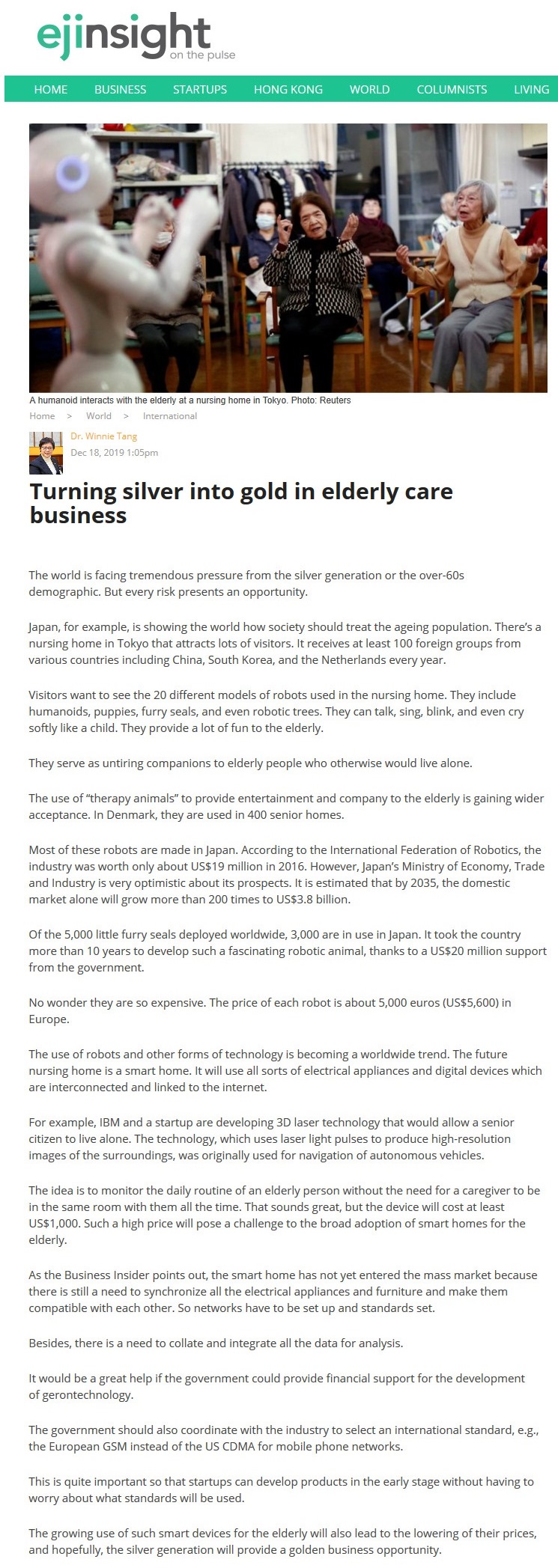網上版請按此

Turning silver into gold in elderly care business
The world is facing tremendous pressure from the silver generation or the over-60s demographic. But every risk presents an opportunity.
Japan, for example, is showing the world how society should treat the ageing population. There's a nursing home in Tokyo that attracts lots of visitors. It receives at least 100 foreign groups from various countries including China, South Korea, and the Netherlands every year.
Visitors want to see the 20 different models of robots used in the nursing home. They include humanoids, puppies, furry seals, and even robotic trees. They can talk, sing, blink, and even cry softly like a child. They provide a lot of fun to the elderly.
They serve as untiring companions to elderly people who otherwise would live alone.
The use of "therapy animals" to provide entertainment and company to the elderly is gaining wider acceptance. In Denmark, they are used in 400 senior homes.
Most of these robots are made in Japan. According to the International Federation of Robotics, the industry was worth only about US$19 million in 2016. However, Japan's Ministry of Economy, Trade and Industry is very optimistic about its prospects. It is estimated that by 2035, the domestic market alone will grow more than 200 times to US$3.8 billion.
Of the 5,000 little furry seals deployed worldwide, 3,000 are in use in Japan. It took the country more than 10 years to develop such a fascinating robotic animal, thanks to a US$20 million support from the government.
No wonder they are so expensive. The price of each robot is about 5,000 euros (US$5,600) in Europe.
The use of robots and other forms of technology is becoming a worldwide trend. The future nursing home is a smart home. It will use all sorts of electrical appliances and digital devices which are interconnected and linked to the internet.
For example, IBM and a startup are developing 3D laser technology that would allow a senior citizen to live alone. The technology, which uses laser light pulses to produce high-resolution images of the surroundings, was originally used for navigation of autonomous vehicles.
The idea is to monitor the daily routine of an elderly person without the need for a caregiver to be in the same room with them all the time. That sounds great, but the device will cost at least US$1,000. Such a high price will pose a challenge to the broad adoption of smart homes for the elderly.
As the Business Insider points out, the smart home has not yet entered the mass market because there is still a need to synchronize all the electrical appliances and furniture and make them compatible with each other. So networks have to be set up and standards set.
Besides, there is a need to collate and integrate all the data for analysis.
It would be a great help if the government could provide financial support for the development of gerontechnology.
The government should also coordinate with the industry to select an international standard, e.g., the European GSM instead of the US CDMA for mobile phone networks.
This is quite important so that startups can develop products in the early stage without having to worry about what standards will be used.
The growing use of such smart devices for the elderly will also lead to the lowering of their prices, and hopefully, the silver generation will provide a golden business opportunity.
Dr. Winnie Tang
Adjunct Professor, Department of Computer Science, Faculty of Engineering and Faculty of Architecture, The University of Hong Kong